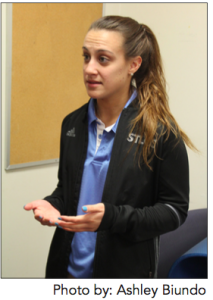Athletic Trainer Michele Rava talks about coming back from injuries
By: Missy Arneson
Copy Editor
Injuries are unavoidable in sports, according to St. Louis Community College Athletic Trainer Michele Rava. Rava said she has worked with all of the campus sports teams since December. She said that the athletic trainers’ main focus is the health of the athletes.
“You always want to think as an athletic trainer about the athletes’ well-being,” Rava said.
She believes wholeheartedly in the RICE treatment for minor injuries.
“Rest, ice, compression and elevation,” Rava said. “When you get something like an ankle injury, you roll your ankle, you want to make sure that you’re resting and not going to go run some more on it.”
For more major injuries, Rava said to listen very closely to the doctor’s instructions.
“When it comes to things that keep an athlete out for a long period of time or they have to see a doctor for, maybe they’re in a cast for a broken bone or something like that, we … have to listen to what the doctor says,” Rava said. “Let’s use the example of a broken ankle. Once the cast is off and they’re allowed to move it around a little bit, we focus on decreasing pain and swelling, and then once we get the okay from [the doctor] … then [we] go on to rehab … if they see a doctor, we always have to wait for the doctor to say they’re clear to go back.”
But exactly how often do athletes get injured?
“Oh goodness, a lot,” Rava said.
She said there is a scale of injuries ranging from minor to major, and minor ones are much more common.
“[An injury] could be something minor that happens a couple time a day,” Rava said. “Or [it could be] something major, which we hope doesn’t happen at all, but every now and then there are some major injuries that do happen. I would say during a game that somebody gets an injury [usually minor] about once a game.”
These minor injuries like sprained ankles and jammed fingers are unfortunate, but preferable to major injuries.
“I got surgery last November,” Meramec student and athlete Hunter McDonald said. “I’ve done physical therapy and I’m doing my throwing stuff, but it’s starting to hurt again so I have to go in and maybe get surgery again.”
Rava said that athletes have to be seriously injured for her to recommend they not come back to sports.
“It’s tough, because our job is to try to get them back to sports,” Rava said. “‘If’ they’ve had … a big number of concussions in their life, we start to think, ‘how is that going to impact their future?’ … if somebody is prone to certain injuries, or they have an injury that keeps happening and keeps happening … maybe this is not time to get back to this sport anymore, maybe it’s time to think about something else you want to do. Because we also want to think about their future after sports.”











